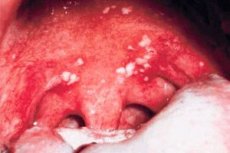Medical expert of the article
New publications
Herpangina
Last reviewed: 04.07.2025

All iLive content is medically reviewed or fact checked to ensure as much factual accuracy as possible.
We have strict sourcing guidelines and only link to reputable media sites, academic research institutions and, whenever possible, medically peer reviewed studies. Note that the numbers in parentheses ([1], [2], etc.) are clickable links to these studies.
If you feel that any of our content is inaccurate, out-of-date, or otherwise questionable, please select it and press Ctrl + Enter.

Epidemiology
The source of the infectious agent is only a sick person or a virus carrier. The infection is transmitted by airborne droplets and feco-oral routes. The contagiousness of patients from the 7-8th day of illness decreases sharply. Herpangina disease is widespread, both sporadic cases and outbreaks and epidemics are observed. Mostly children and adolescents are ill. Immunity after the disease is stable, long-lasting, however, in rare cases, re-infection with the Coxsackie virus group A of another serotype is possible.
Causes herpangines
In 1948, American virologists G.Doldorf and G.Sickles described the properties of a new virus isolated from the intestinal contents of sick children with symptoms of CNS damage. The virus was named "Coxsackie", after the city of Coxsackie (USA), where the hospital with the examined children was located. Later, based on virological studies, G.Doldorf divided all the obtained types of Coxsackie virus into two groups - A and B. The first included 19 serotypes, of which herpangina is caused by serotypes 2, 4, 5, 6, 8 and 10. At present, it is generally accepted that Coxsackie viruses, which are representatives of the picornavirus family of the enterovirus genus, are divided into group A (24 serotypes) and group B (6 serotypes).
The pathological anatomy of such forms of the disease as epidemic myalgia, herpangina and serous meningitis in humans has not been studied, since these forms of the disease always end in recovery. A severe clinical picture and high mortality (70% in the 20th century) are observed only in neonatal myocarditis caused by the Coxsackie virus.
Pathogens
Symptoms herpangines
The symptoms of herpangina and diseases caused by the Coxsackie virus are extremely diverse, while the methods of diagnosis, treatment, prognosis and prevention have much in common. Herpangina begins suddenly with a rise in body temperature to 39-40 ° C, which persists for 2-3 days, and then drops critically. In some patients, vomiting and sometimes cramping abdominal pain occur against the background of fever. The most characteristic changes develop in the structures of the pharynx. On the 1-2nd day of the disease, small papules 1-2 mm in diameter appear on the hyperemic mucous membrane of the palatine arches, uvula, tonsils, soft and hard palate, tongue, which quickly turn into vesicles. After 2-3 days, the vesicles burst, and erosions covered with a grayish-white coating form at their bottom; a narrow border of hyperemia is noted around them. The appearance of blisters and erosions is accompanied by moderate pain when swallowing, but in some cases these pains are excruciating and are accompanied by profuse salivation. Regional lymph nodes increase in size. By the 4th to 7th day of the disease, changes in the pharynx disappear in most patients.
Herpangina is often accompanied by vesicular stomatitis with skin manifestations, characterized by a combination of vesicular stomatitis with skin lesions. In the oral cavity, blisters and ulcers are localized on the tongue, gums, soft palate, and mucous membrane of the cheeks. Skin manifestations are characterized by the appearance of blisters on the feet and hands. In some cases, the rash is accompanied by a rise in body temperature. The disease is mild and ends on the 6th-7th day. Erosions in the oral cavity do not leave any traces after disappearing.
Where does it hurt?
Diagnostics herpangines
Diagnosis is difficult because many viral diseases of the throat have similar symptoms at the initial stages, and only as the disease develops do they acquire their own characteristics, which are also not always easy to distinguish. Final diagnosis is possible only by isolating the virus from the feces and swabs from the patient's throat and determining the titer of antibodies to this virus in the blood, as well as using the immunofluorescence method, which determines the presence of specific virus antigens in the materials being studied, as well as serological studies (neutralization reaction, complement fixation reaction, hemagglutination inhibition reaction). Epidemiological data play a certain role in diagnosis.
What do need to examine?
How to examine?
What tests are needed?
Who to contact?
Treatment herpangines
Treatment of herpangina is practically no different from the treatment of other uncomplicated viral tonsillitis and pharyngitis and is mainly symptomatic (rinsing, painkillers, vitamins, etc.). Patients with severe intoxication, Coxsackie meningitis or myocarditis are subject to hospitalization, other patients are isolated at home.
Prescribe a gentle regimen, easily digestible vitamin-rich food, plenty of fluids, analgesics for severe headaches and muscle pain, and antipyretics for hyperthermia. Prescribe B vitamins, high doses of vitamin C, and antihistamines (diphenhydramine, pipolfen, suprastin, calcium preparations). In case of severe intoxication, detoxification therapy (intravenous water-salt solutions and glucose).
Forecast
The prognosis, except for complications of encephalitis and myocarditis in newborns, is favorable.
 [ 18 ]
[ 18 ]

